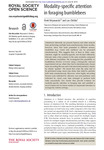Please use this identifier to cite or link to this item:
http://lib.hpu.edu.vn/handle/123456789/21684Full metadata record
| DC Field | Value | Language |
|---|---|---|
| dc.contributor.author | Nityananda, Vivek | en_US |
| dc.contributor.author | Chittka, Lars | en_US |
| dc.date.accessioned | 2016-06-25T01:57:04Z | |
| dc.date.available | 2016-06-25T01:57:04Z | |
| dc.date.issued | 2015 | en_US |
| dc.identifier.other | HPU4160303 | en_US |
| dc.identifier.uri | https://lib.hpu.edu.vn/handle/123456789/21684 | - |
| dc.description.abstract | Attentional demands can prevent humans and other animals from performing multiple tasks simultaneously. Some studies, however, show that tasks presented in different sensory modalities (e.g. visual and auditory) can be processed simultaneously. This suggests that, at least in these cases, attention might be modality-specific and divided differently between tasks when present in the same modality compared with different modalities. | en_US |
| dc.format.extent | 10 p. | en_US |
| dc.format.mimetype | application/pdf | - |
| dc.language.iso | en | en_US |
| dc.publisher | The Royal Society | en_US |
| dc.subject | Biology | en_US |
| dc.subject | Behaviour | en_US |
| dc.subject | Ecology | en_US |
| dc.subject | Neuroscience | en_US |
| dc.subject | Bombus terrestris | en_US |
| dc.subject | Crossmodal attention | en_US |
| dc.subject | Divided attention | en_US |
| dc.subject | Foraging | en_US |
| dc.subject | Predation | en_US |
| dc.title | Modality specific attention in foraging bumblebees | en_US |
| dc.type | Book | en_US |
| dc.size | 537KB | en_US |
| dc.department | Education | en_US |
| Appears in Collections: | Education | |
Files in This Item:
| File | Description | Size | Format | |
|---|---|---|---|---|
| 0186_Modalityspecificattention.pdf Restricted Access | 537.27 kB | Adobe PDF |  View/Open Request a copy |
Items in DSpace are protected by copyright, with all rights reserved, unless otherwise indicated.
